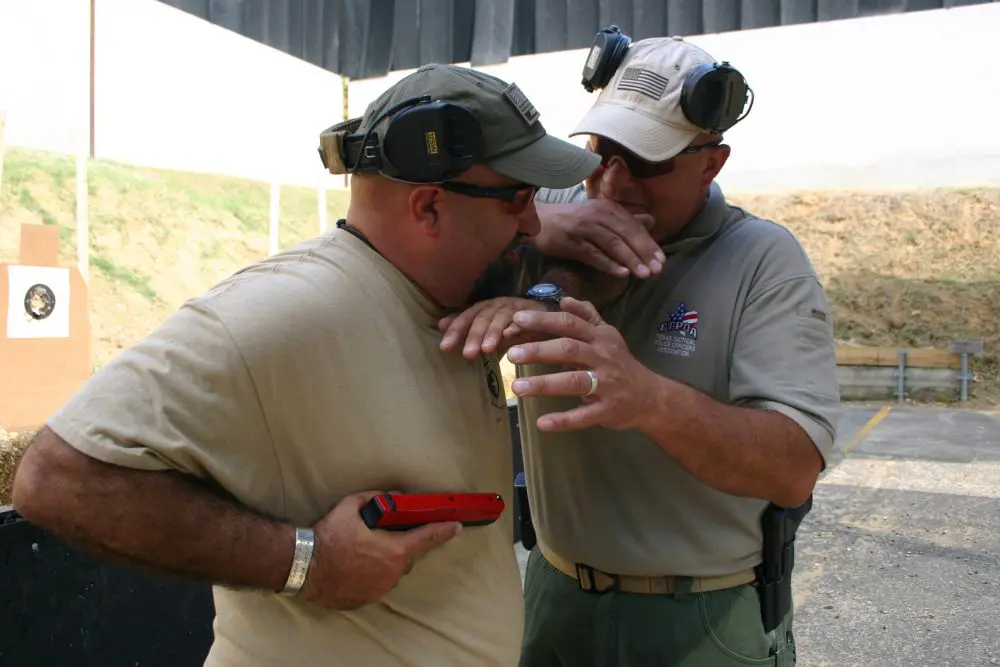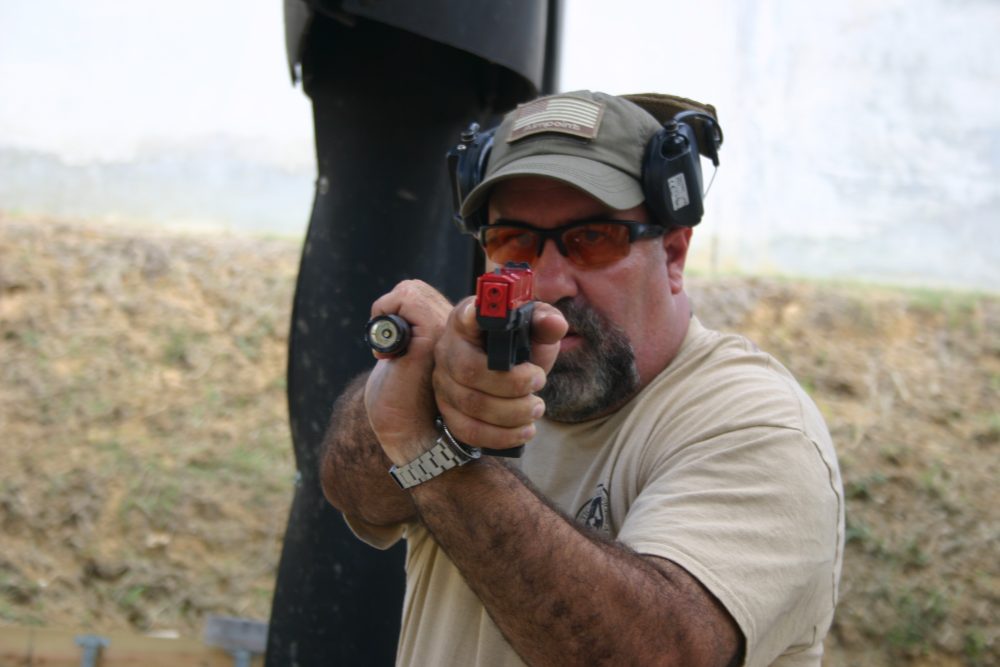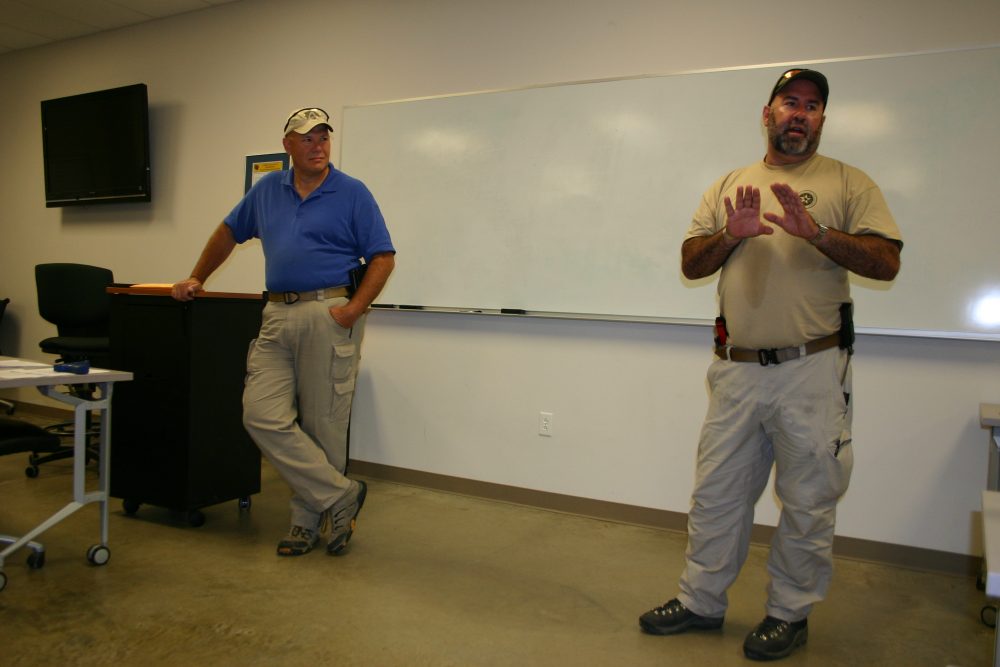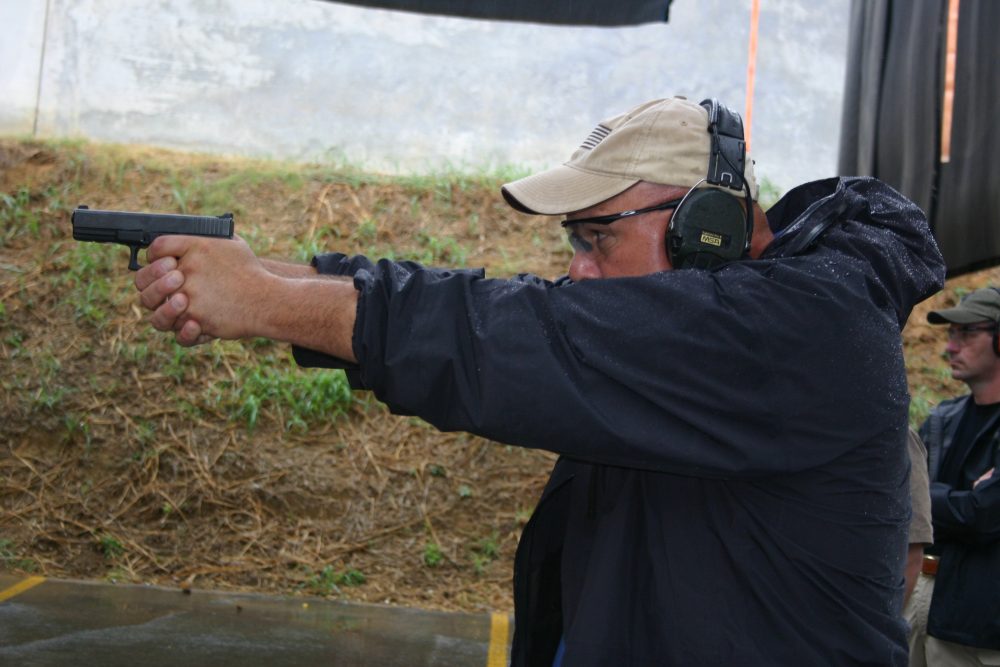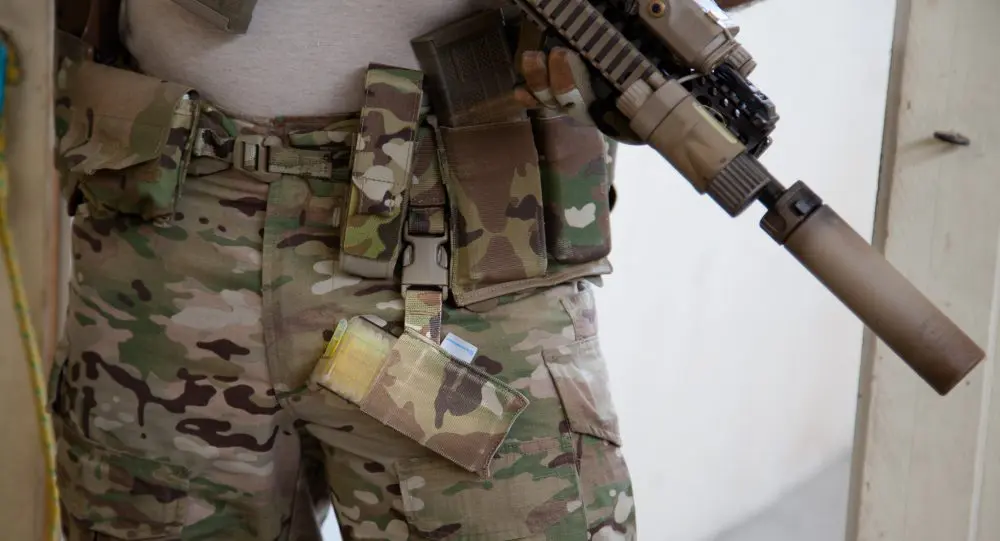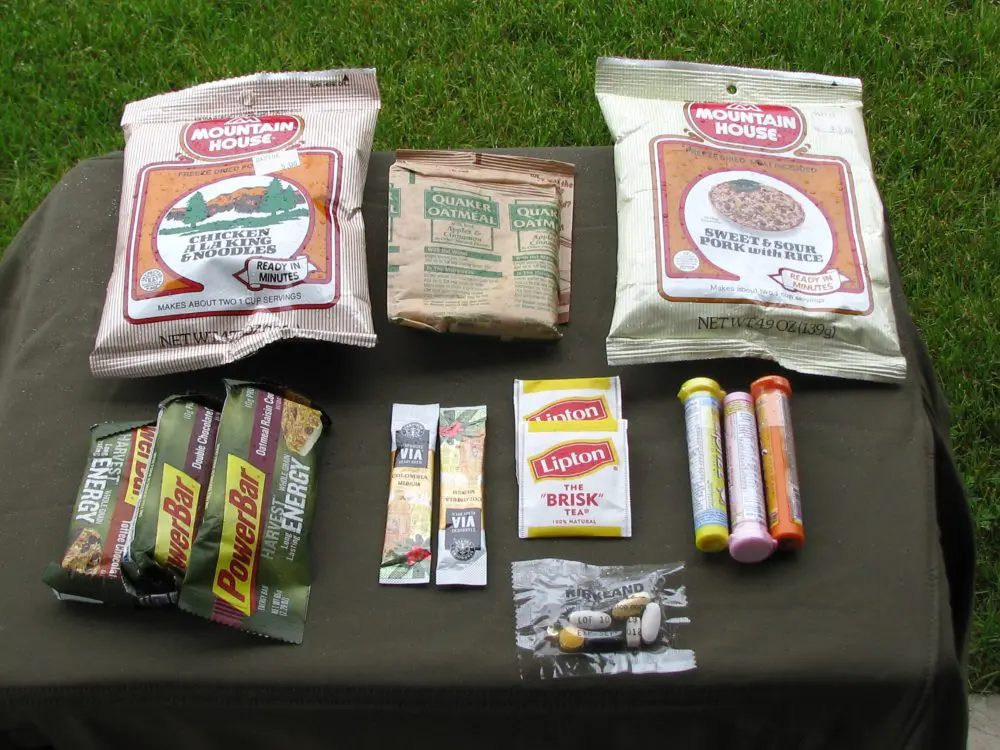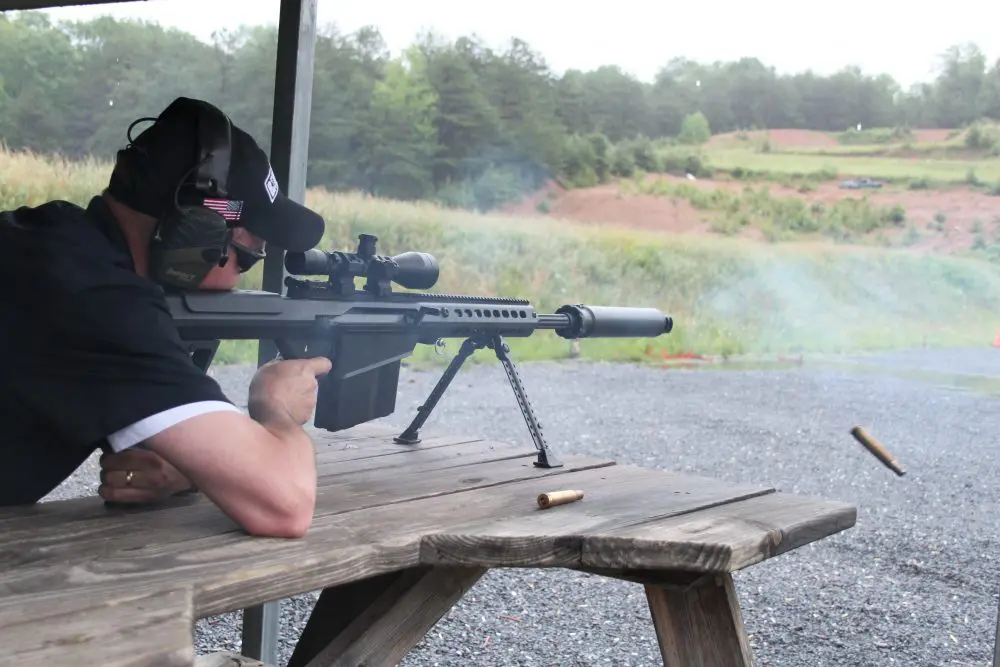Darryl Bolke demonstrates standard Harries light hold.
The phrase “first responder” is overused. But the fact is that if you are present when violence erupts and threatens your safety, by default you become a first responder.
This applies whether you are a cop arriving at the scene of a shooting in progress or a private citizen who finds himself on the receiving end of an attack. Hardwired Tactical Shooting Instructor Darryl Bolke summarizes it more succinctly: “When someone breaks into your house at 3am, you are now the first responder.
Table of Contents
HiTS MEN
Darryl Bolke and Wayne Dobbs, two retired LEOs with over 45 combined years of law enforcement experience, teamed up to form their own company, Hardwired Tactical Shooting (HiTS).
Recently they created their two-day First Responder handgun class. The objective is not simply to teach shooting, but also to train students to develop a hardwired response to lethal threats.
Darryl and Wayne both served in a wide variety of capacities with their respective agencies and have remained active after their retirement.
Darryl Bolke demonstrates reverse Harries light hold.
Darryl spent almost two decades working out of the patrol division of his former West Coast agency, where he served as a firearms trainer assigned to SWAT, helicopter flight officer, and Field Training Officer, among other roles.
Darryl sought out instruction from LAPD’s legendary SWAT team and brought that training back to his department. He was also responsible for the firearms debriefings of over 75 officer-involved shootings, as well as having been in a few himself. Debriefing officers who were involved in shootings gave him an excellent lab to see what worked and what didn’t. Darryl also worked extensively in the executive protection field.
Wayne Dobbs hails from Texas, where he retired after 25 years with the Richardson Police Department, where he worked patrol and SWAT as well as a number of special details, including street crime and narcotics. He also managed his department’s firearms training program for nearly ten years.
After retiring, Wayne spent two years in Iraq with the Department of State Police Training Program, where he went on to develop instructors. As well as being one of a small coterie of Vickers Method Instructors, Wayne teaches firearms and tactics to high-threat protective detail personnel for Triple Canopy.
Neck/jaw index light hold as shown by Darryl Bolke.
COURSE OFFERINGS
Wayne and Darryl base the HiTS program of instruction on their first-hand experiences as well as what they gleaned from the many training giants they have studied with over the years. Darryl and Wayne share many of the same mentors, including Pat Rogers, Larry Vickers, Ken Hackathorn, and Paul Howe. Other significant influences on their program include Scott Reitz, Mark Fricke, Bill Jeans, Larry Mudget, Jeff Gonzales, and Tom Givens.
Throughout the course that I attended, Wayne and Darryl gave credit whenever they taught something they learned from a particular instructor, making sure to pay homage to those who trained them.
The two men have their differences, which work to the students’ advantage and provide an even more well-rounded program of instruction.
Wayne and Darryl employ different shooting stances, for which they articulated their reasons. Wayne favors the Modified Isosceles, while Darryl shoots from a Weaver-based fighting stance. Darryl started his LE career as an Isosceles shooter, but immediately found that a more compressed stance worked better for him—especially when it came to confined spaces and keeping the weapon farther back from potential suspects. Either the Weaver or Isosceles stance fits well into HiTS classes.
Wayne Dobbs works with student on dry fire with Harries Flashlight Technique.
FIRST RESPONDER PISTOL COURSE
The two-day class included students from local PDs, Homeland Security, civilian contractors, and several active-duty Army personnel. Also present were some people who had never been to a formal class. Wayne and Darryl were able to effectively keep everyone progressing without slowing the class down.
The most popular handguns were Glocks, followed by the Smith & Wesson M&P. Other student pistols were a Browning Hi-Power, an HK USP Compact and two 1911s.
After an introductory lecture that reviewed the seven fundamental principles of firearm marksmanship and the Combat Triad, we adjourned to the Dallas Pistol Club’s outdoor range.
Darryl Bolke demonstrates close-quarters shooting technique on Wayne Dobbs.
We used NRA pistol targets with a 5.5-inch bullseye taped to the center of an IDPA silhouette. The only time we were not firing at the bull was when we were shooting at the silhouette’s head as part of a failure drill.
The shooting portion began with slow fire at about 12 feet, concentrating on accuracy as Wayne and Darryl circulated and worked with us individually. We then increased the speed until we were firing as many rounds as we could in two seconds.
The instructors ultimately guided us to the point where we fired as many rounds as we could in two seconds while keeping all our shots in the bullseye, starting from the low ready position.
Over the two days of the class, we shot numerous courses of fire at a variety of distances, adding drawstroke, low-light techniques, shooting on the move, and retention shooting to the mix.
Wayne Dobbs and Darryl Bolke lecture in the classroom.
TWO-SECOND STANDARD
Wayne and Darryl introduced us to drills and training goals built around a two-second standard. This philosophy—based on their experiences and that of many others—holds that the first two seconds of a gunfight are the most critical. Many law enforcement and civilian gunfights were sudden affairs that were over quickly, but required solid hits to end them.
Thus both speed and accuracy are essential to maximize your chances of survival. Darryl and Wayne apply the two-second standard firing from stationary ready positions as well as when the gun most be drawn from the holster or shooting on the move.
Of course, in situations when the gun is already out, more rounds can be fired in two seconds than when the gun must first be drawn. Factors like greater distances or firing on the move require more finesse on the shooter’s part to achieve accurate hits, and thus reduce the number of rounds he can fire in two seconds.
Wayne Dobbs oversees firing line at ten yards.
The number of accurate hits achieved within the time frame varied among students. Some students were only able to fire one accurate shot, while others got off six in the same time frame.
Wayne and Darryl believe in keeping the accuracy standard tight. They wanted students to get the required hits first before working on increasing their speed. The instructors stressed that they wanted us to get comfortable firing at our own speed, and not try to match that of anyone else in the class. By the end of the second day, we saw improvements class-wide—most dramatically with shooters who were new to training.
Shoot and don’t-shoot decisions were added as the drills progressed. We were told to fire only on the timer beep or on the specific commands of “shoot” or “fire.” If any other verbal commands were given, we were instructed to issue verbal commands and keep the target covered, but not fire until further clarification.
Sometimes the instructors threw a curve by screaming “threat” or “he has a gun.” In some cases they told us that the subject was running away; in others they said he was attacking.
This helped incorporate the threat assessment and decision making skills that are always present in real life into the range drills. The instructors pointed out that speed is fine until you are moving faster than you can process information.
Wayne Dobbs works with student on dry-fire drill with coin balanced on front sight.
LOW-LIGHT SHOOTING
On the second day, Darryl introduced his take on low-light shooting. He favors the Harries stance, explaining that it is built around the way in which people naturally hold a flashlight so it can serve as both a light and a weapon—held like a club—with the lens part protruding from the bottom of the fist.
Darryl demonstrated several other commonly taught methods of holding a flashlight and asked the class if anyone would be comfortable fighting while holding a light in those fashions. While some flashlight positions might be okay for using the light to search, they would not be practical for use in conjunction with shooting. He pointed out that many methods taught to hold a flashlight and a handgun are awkward and weak. Having worked nights for much of his LE career, Darryl often found himself and his partner called to search buildings. He quickly discovered what works and what doesn’t.
Darryl teaches a system based on the Harries Flashlight Technique that emphasizes the ability to flow among three positions to hold the light, depending on the situation. The first is the neck/jaw index, with the flashlight held in the support hand by the side of the neck. This is most useful for searching, since it keeps the gun hand free to draw the gun or hold it if it’s already been drawn.
Wayne Dobbs demonstrates his preferred shooting stance.
Next is the Harries handgun and light hold most commonly associated with the name, with the back of the flashlight hand held against the outside of the gun hand’s wrist, creating pressure to hold the gun in place. The light hand position can be switched and held against the inside of the gun hand’s wrist if using the light and gun around left-side cover for a handgun held in the right hand. This is known as a reverse Harries.
Both Darryl and Wayne stressed that the best way to practice with a handheld light in conjunction with a handgun is by utilizing a blue gun and light in your own home. They urged us to buy non-firing replicas of the handguns we use for self-defense.
Like many other skills covered in the class, first we practiced the different light techniques in conjunction with unloaded firearms, then moved to live fire after the instructors had observed us and were satisfied that we were safe.
When moving into any of the flashlight positions, it was vital to avoid your muzzle sweeping your gun hand. To accomplish this, we practiced bringing the light hand to our chests before the gun was extended, so we didn’t muzzle-sweep that hand.
Both instructors suggested we study news reports of where and how crimes occur, to be better able to avoid the places and situations that lead to becoming crime victims and to recognize emerging threats and be ready to act if necessary. “If you go places where victims go, or do things that victims do, you may very well find yourself a victim,” Darryl warned.
By the time the two days were over, we had fired just over 600 rounds. I saw very few malfunctions in this class. My Black Hills ammo ran as reliably as I’ve come to expect from it.
Shooting on the move in small groups under Wayne’s supervision.
CONCLUSIONS
With Hardwired Tactical Shooting, you have two instructors whom savvy readers would flock to train with individually and who are now combining their talents. The end result is an exceptionally well-rounded handgun class. Their goal is to pare down what works well and hardwire it in, so that in a fight you can work at maximum efficiency with minimal thought process. They plan to extend this methodology and philosophy to other firearms classes they will be offering.
Never ones to rest on their laurels, Wayne and Darryl continue to study with other acknowledged experts and plan to form strategic alliances with trainers such as knife and unarmed specialist Steve Tarani, and bring them in on HiTS training classes.
SOURCES:
Hardwired Tactical Shooting
www.hardwiredtacticalshooting.com
Black Hills Ammunition
(605) 348-5150
www.black-hills.com
Dallas Pistol Club
(972) 242-9770
www.dallaspistolclub.com
